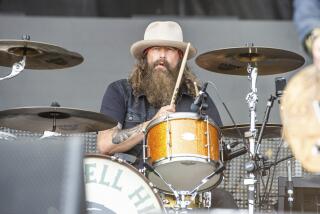Hubert Sumlin dies at 80; guitarist shaped Howlin’ Wolf’s sound
When Howlin’ Wolf romped through “Wang Dang Doodle” or thundered in “Three Hundred Pounds of Joy,” the snarling guitar that accompanied him belonged to one of the greatest bluesmen to pick up the instrument: Hubert Sumlin.
The cry of Sumlin’s guitar — riffing hard one moment, sighing poetically the next — helped define Wolf’s sound, even if Sumlin never attained a fraction of the fame of his celebrated boss.
In the wake of Sumlin’s death Sunday at age 80, of heart failure in Wayne, N.J., Chicago blues musicians tried to put his outsized contributions in focus.
“He’s the one that shaped that Howlin’ Wolf sound,” said septuagenarian Chicago blues guitarist Eddy “The Chief” Clearwater. “On tunes like ‘Shake for Me’ and ‘Smokestack Lightning’ — that was the Howlin’ Wolf sound, and Hubert’s guitar made it.”
That sound still resonates in our popular culture, Sumlin’s guitar humming in the background of a Viagra TV ad featuring “Smokestack Lightning.”
For blues listeners, it’s difficult to separate the roar of Wolf’s vocals from the lacerating guitar lines that accompanied them, Sumlin’s counterpoint a testament to his ingenuity as a blues improviser.
“He was different — he produced a different sound that other guys couldn’t get,” said veteran Chicago blues saxophonist Eddie Shaw, who played alongside Sumlin in Wolf’s band for 13 years.
Eric “Clapton wanted it. All the guys from overseas wanted it.... Everybody wanted to get that Hubert Sumlin sound.”
Little wonder that Clapton and Rolling Stone Keith Richards volunteered to play sideman for Sumlin on his Grammy-nominated album “About Them Shoes” (2005). In so doing, the guitar gods paid homage to a less-celebrated deity who had pointed the way for them.
Born in 1931 in the Mississippi Delta — in Greenwood, Miss. — and raised in Hughes, Ark., the self-taught guitarist collaborated with future harmonica star James Cotton before either was known to the world. By the early 1950s, Wolf brought Sumlin to Chicago and mentored him before the listening public, transforming a somewhat shy, soft-spoken young man into a ferocious presence — once Sumlin strapped on his guitar.
The two men made staggering music together, but they sometimes battled with equal intensity off the bandstand.
Showing up after a gig had ended in Little Rock, Ark., in the 1950s, Sumlin nonchalantly piled into the car heading to the next date. It didn’t take long before Wolf interrupted the journey, dragged Sumlin out of the vehicle and shoved him down a hill, costing the musician two front teeth.
“He was a big man, and he scared me half to death!” Sumlin said in a Tribune interview earlier this year.
A few days later, Sumlin turned up unannounced at Silvio’s, a landmark Chicago blues club where the Wolf often howled, and cocked his fist.
“I hit him!” Sumlin recalled in the Tribune interview. “I knocked his teeth out, too. And afterward, he laughed.... I hated I did it. I apologized. But you know what the guy did? We went back to work.”
This kind of intramural violence was not uncommon in an earlier, more rough-and-tumble blues era, and that feral energy made its way onto recordings, assuring both Wolf and Sumlin a measure of musical immortality.
After the 1976 death of Wolf (born Chester Arthur Burnett), Sumlin eventually came into his own as bandleader and emerging vocalist, issuing critically acclaimed recordings that were more muted than those of his old boss.
Though nominated for several Grammys, Sumlin never won, yet he achieved the highest esteem of his peers.
“He can be imitated,” said former colleague Shaw, “but never duplicated.”
Sumlin’s wife, Willie B. “Rea” Reed Sumlin, died in 1999.
More to Read
Start your day right
Sign up for Essential California for the L.A. Times biggest news, features and recommendations in your inbox six days a week.
You may occasionally receive promotional content from the Los Angeles Times.




















































